Comprehensive Business Communications Report: A Detailed Analysis
VerifiedAdded on 2023/03/20
|12
|3721
|73
Report
AI Summary
This report provides a detailed overview of various aspects of business communication. It begins by defining and exploring verbal and non-verbal communication, including examples of their application in business scenarios. The report then delves into the importance of effective listening skills and how they contribute to building positive business relationships. It further examines strategies for managing business relationships, resolving conflicts, and negotiating successfully. The report also covers personal interactions and the significance of written communication in business, providing examples of each. Furthermore, it touches upon intercultural communication and the role of social media in modern business communication. The report uses real-world examples to illustrate each concept, making it a comprehensive guide to understanding and improving business communication practices.
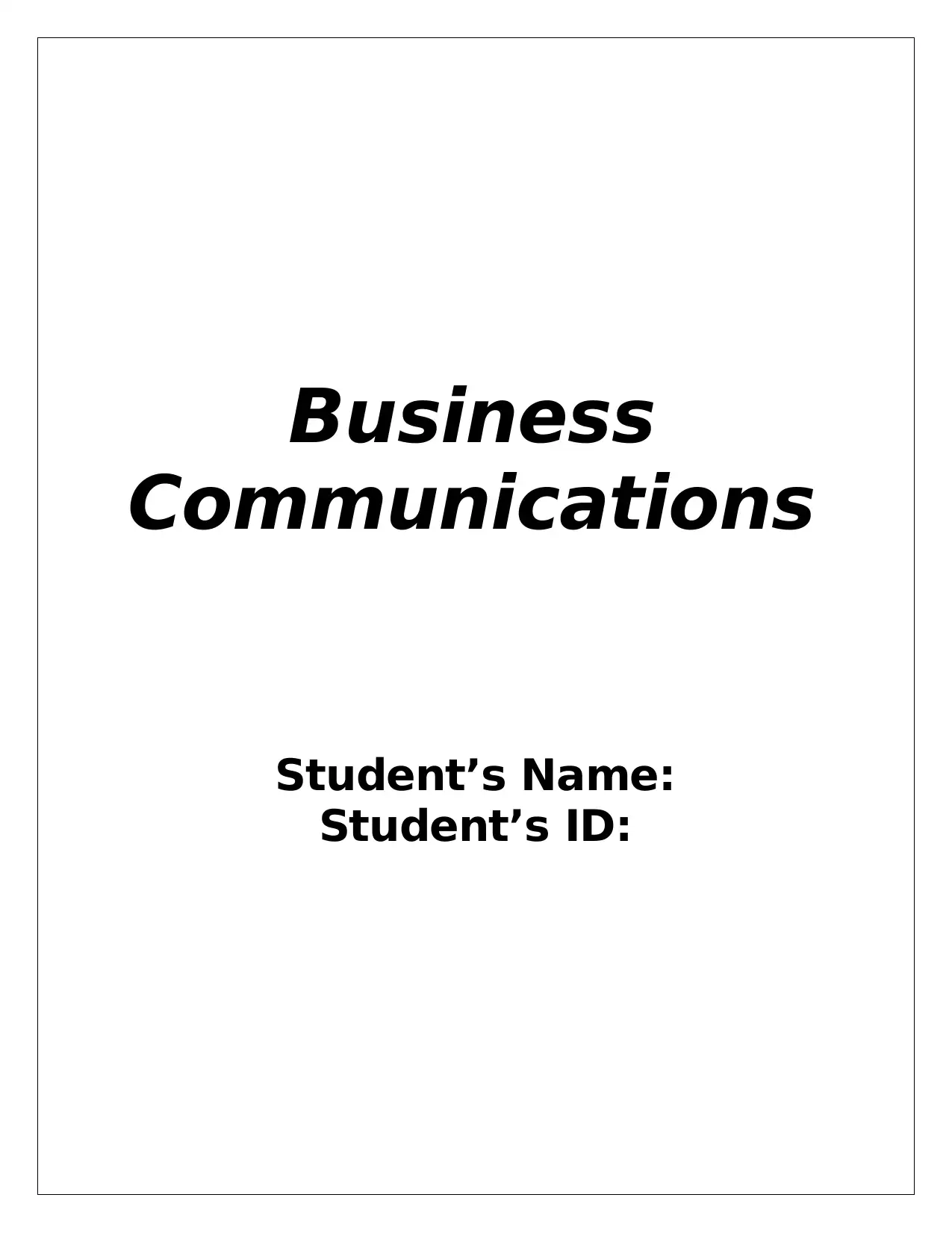
Business
Communications
Student’s Name:
Student’s ID:
Communications
Student’s Name:
Student’s ID:
Paraphrase This Document
Need a fresh take? Get an instant paraphrase of this document with our AI Paraphraser
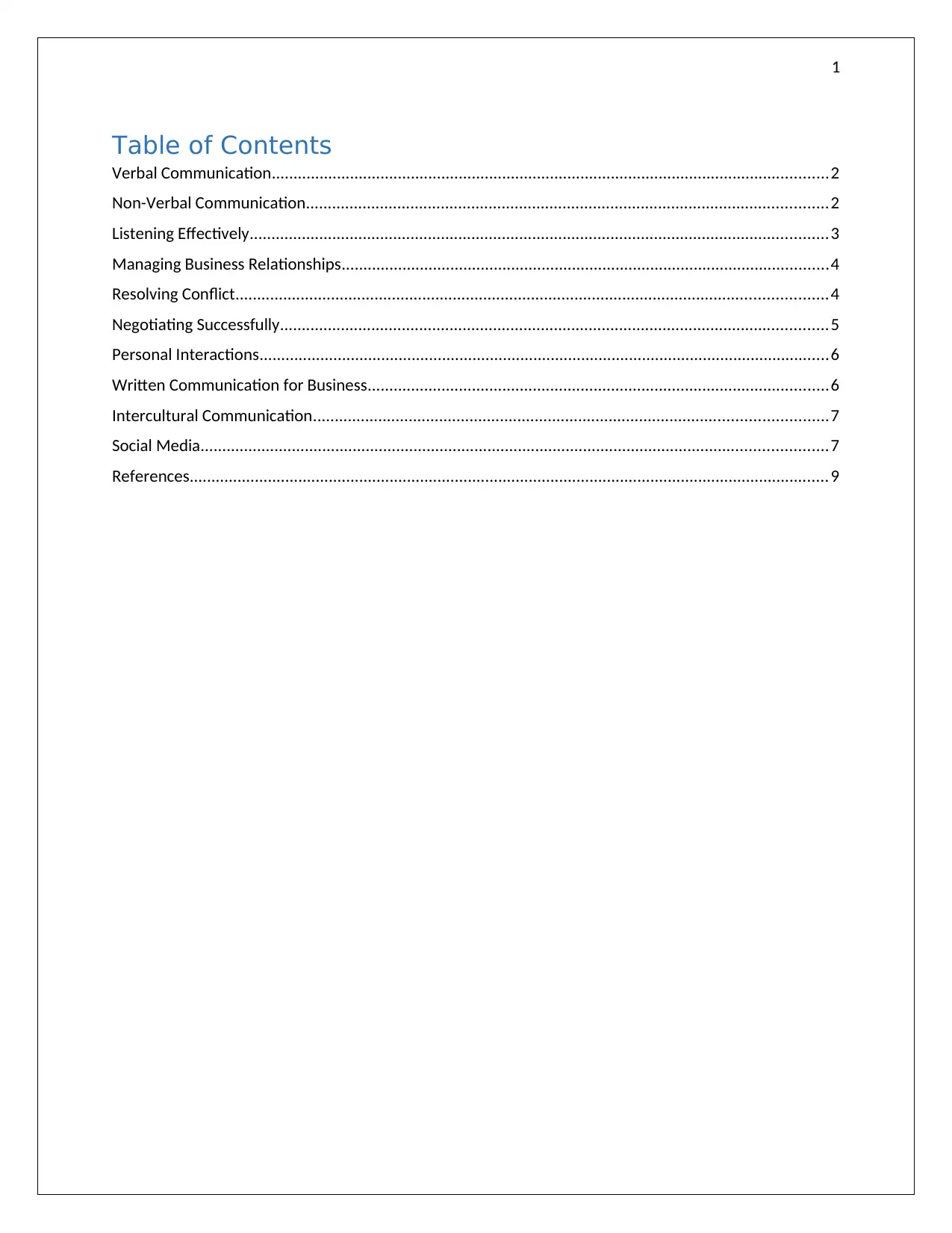
1
Table of Contents
Verbal Communication................................................................................................................................2
Non-Verbal Communication........................................................................................................................2
Listening Effectively.....................................................................................................................................3
Managing Business Relationships................................................................................................................4
Resolving Conflict........................................................................................................................................4
Negotiating Successfully..............................................................................................................................5
Personal Interactions...................................................................................................................................6
Written Communication for Business..........................................................................................................6
Intercultural Communication......................................................................................................................7
Social Media................................................................................................................................................7
References...................................................................................................................................................9
Table of Contents
Verbal Communication................................................................................................................................2
Non-Verbal Communication........................................................................................................................2
Listening Effectively.....................................................................................................................................3
Managing Business Relationships................................................................................................................4
Resolving Conflict........................................................................................................................................4
Negotiating Successfully..............................................................................................................................5
Personal Interactions...................................................................................................................................6
Written Communication for Business..........................................................................................................6
Intercultural Communication......................................................................................................................7
Social Media................................................................................................................................................7
References...................................................................................................................................................9
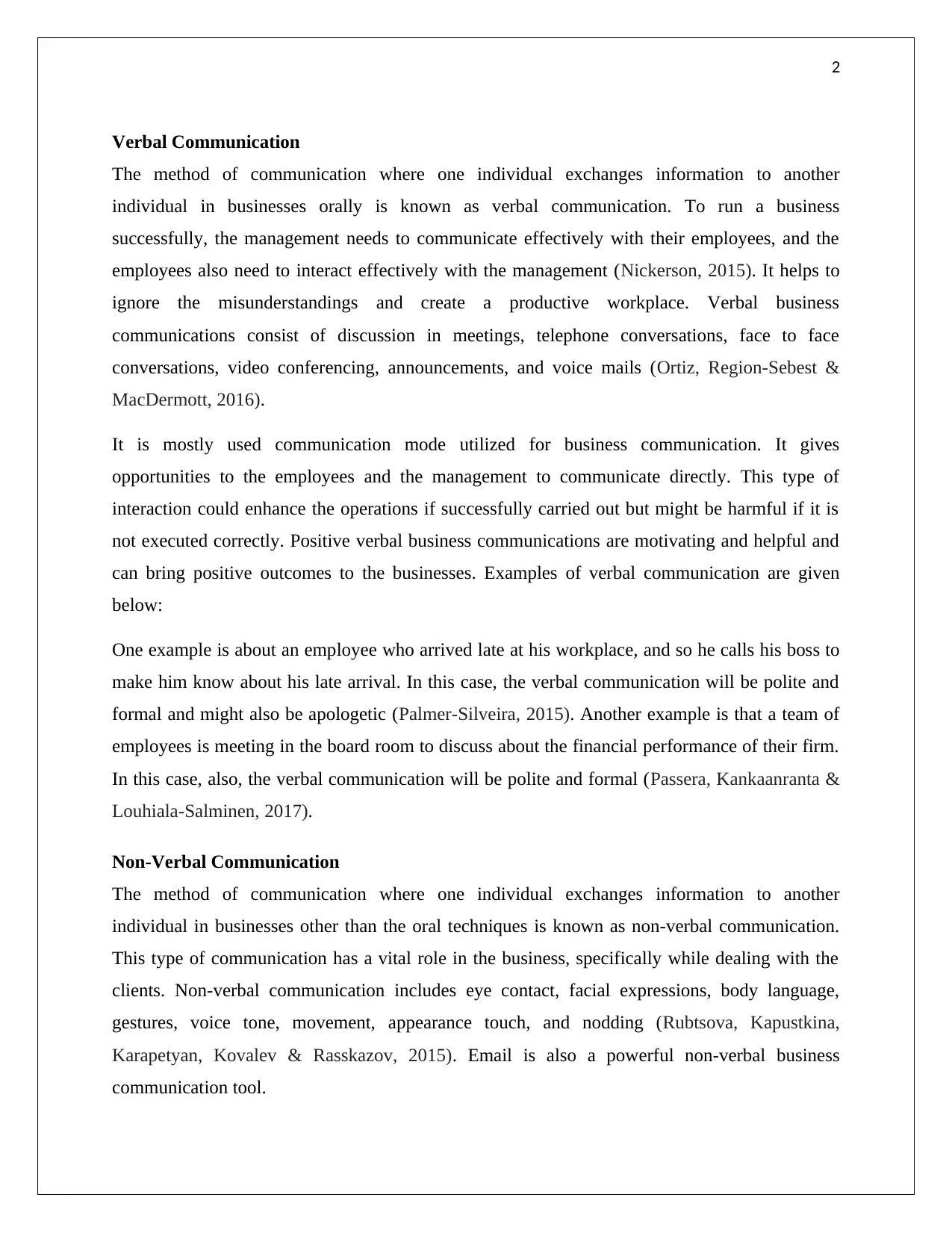
2
Verbal Communication
The method of communication where one individual exchanges information to another
individual in businesses orally is known as verbal communication. To run a business
successfully, the management needs to communicate effectively with their employees, and the
employees also need to interact effectively with the management (Nickerson, 2015). It helps to
ignore the misunderstandings and create a productive workplace. Verbal business
communications consist of discussion in meetings, telephone conversations, face to face
conversations, video conferencing, announcements, and voice mails (Ortiz, Region-Sebest &
MacDermott, 2016).
It is mostly used communication mode utilized for business communication. It gives
opportunities to the employees and the management to communicate directly. This type of
interaction could enhance the operations if successfully carried out but might be harmful if it is
not executed correctly. Positive verbal business communications are motivating and helpful and
can bring positive outcomes to the businesses. Examples of verbal communication are given
below:
One example is about an employee who arrived late at his workplace, and so he calls his boss to
make him know about his late arrival. In this case, the verbal communication will be polite and
formal and might also be apologetic (Palmer-Silveira, 2015). Another example is that a team of
employees is meeting in the board room to discuss about the financial performance of their firm.
In this case, also, the verbal communication will be polite and formal (Passera, Kankaanranta &
Louhiala-Salminen, 2017).
Non-Verbal Communication
The method of communication where one individual exchanges information to another
individual in businesses other than the oral techniques is known as non-verbal communication.
This type of communication has a vital role in the business, specifically while dealing with the
clients. Non-verbal communication includes eye contact, facial expressions, body language,
gestures, voice tone, movement, appearance touch, and nodding (Rubtsova, Kapustkina,
Karapetyan, Kovalev & Rasskazov, 2015). Email is also a powerful non-verbal business
communication tool.
Verbal Communication
The method of communication where one individual exchanges information to another
individual in businesses orally is known as verbal communication. To run a business
successfully, the management needs to communicate effectively with their employees, and the
employees also need to interact effectively with the management (Nickerson, 2015). It helps to
ignore the misunderstandings and create a productive workplace. Verbal business
communications consist of discussion in meetings, telephone conversations, face to face
conversations, video conferencing, announcements, and voice mails (Ortiz, Region-Sebest &
MacDermott, 2016).
It is mostly used communication mode utilized for business communication. It gives
opportunities to the employees and the management to communicate directly. This type of
interaction could enhance the operations if successfully carried out but might be harmful if it is
not executed correctly. Positive verbal business communications are motivating and helpful and
can bring positive outcomes to the businesses. Examples of verbal communication are given
below:
One example is about an employee who arrived late at his workplace, and so he calls his boss to
make him know about his late arrival. In this case, the verbal communication will be polite and
formal and might also be apologetic (Palmer-Silveira, 2015). Another example is that a team of
employees is meeting in the board room to discuss about the financial performance of their firm.
In this case, also, the verbal communication will be polite and formal (Passera, Kankaanranta &
Louhiala-Salminen, 2017).
Non-Verbal Communication
The method of communication where one individual exchanges information to another
individual in businesses other than the oral techniques is known as non-verbal communication.
This type of communication has a vital role in the business, specifically while dealing with the
clients. Non-verbal communication includes eye contact, facial expressions, body language,
gestures, voice tone, movement, appearance touch, and nodding (Rubtsova, Kapustkina,
Karapetyan, Kovalev & Rasskazov, 2015). Email is also a powerful non-verbal business
communication tool.
⊘ This is a preview!⊘
Do you want full access?
Subscribe today to unlock all pages.

Trusted by 1+ million students worldwide
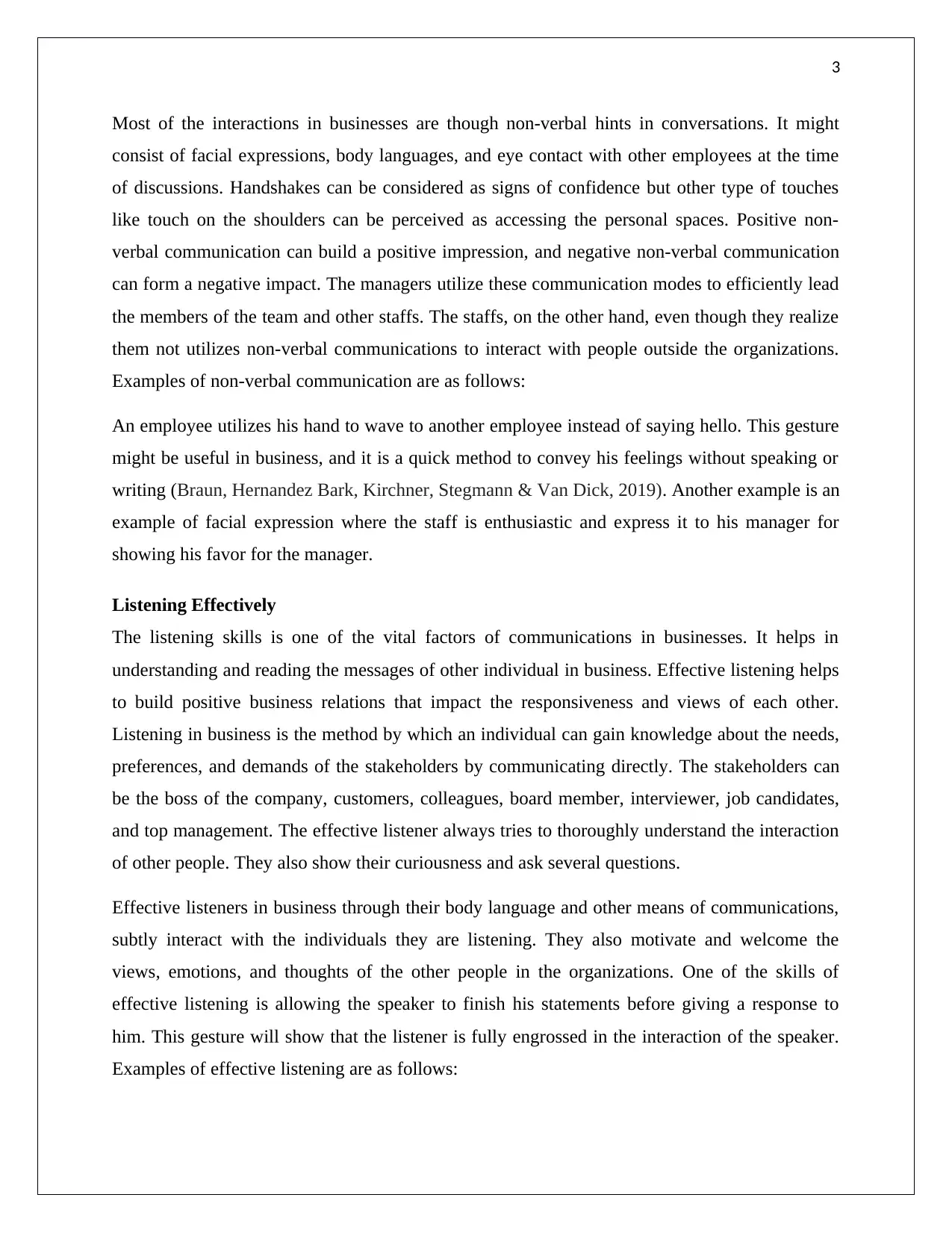
3
Most of the interactions in businesses are though non-verbal hints in conversations. It might
consist of facial expressions, body languages, and eye contact with other employees at the time
of discussions. Handshakes can be considered as signs of confidence but other type of touches
like touch on the shoulders can be perceived as accessing the personal spaces. Positive non-
verbal communication can build a positive impression, and negative non-verbal communication
can form a negative impact. The managers utilize these communication modes to efficiently lead
the members of the team and other staffs. The staffs, on the other hand, even though they realize
them not utilizes non-verbal communications to interact with people outside the organizations.
Examples of non-verbal communication are as follows:
An employee utilizes his hand to wave to another employee instead of saying hello. This gesture
might be useful in business, and it is a quick method to convey his feelings without speaking or
writing (Braun, Hernandez Bark, Kirchner, Stegmann & Van Dick, 2019). Another example is an
example of facial expression where the staff is enthusiastic and express it to his manager for
showing his favor for the manager.
Listening Effectively
The listening skills is one of the vital factors of communications in businesses. It helps in
understanding and reading the messages of other individual in business. Effective listening helps
to build positive business relations that impact the responsiveness and views of each other.
Listening in business is the method by which an individual can gain knowledge about the needs,
preferences, and demands of the stakeholders by communicating directly. The stakeholders can
be the boss of the company, customers, colleagues, board member, interviewer, job candidates,
and top management. The effective listener always tries to thoroughly understand the interaction
of other people. They also show their curiousness and ask several questions.
Effective listeners in business through their body language and other means of communications,
subtly interact with the individuals they are listening. They also motivate and welcome the
views, emotions, and thoughts of the other people in the organizations. One of the skills of
effective listening is allowing the speaker to finish his statements before giving a response to
him. This gesture will show that the listener is fully engrossed in the interaction of the speaker.
Examples of effective listening are as follows:
Most of the interactions in businesses are though non-verbal hints in conversations. It might
consist of facial expressions, body languages, and eye contact with other employees at the time
of discussions. Handshakes can be considered as signs of confidence but other type of touches
like touch on the shoulders can be perceived as accessing the personal spaces. Positive non-
verbal communication can build a positive impression, and negative non-verbal communication
can form a negative impact. The managers utilize these communication modes to efficiently lead
the members of the team and other staffs. The staffs, on the other hand, even though they realize
them not utilizes non-verbal communications to interact with people outside the organizations.
Examples of non-verbal communication are as follows:
An employee utilizes his hand to wave to another employee instead of saying hello. This gesture
might be useful in business, and it is a quick method to convey his feelings without speaking or
writing (Braun, Hernandez Bark, Kirchner, Stegmann & Van Dick, 2019). Another example is an
example of facial expression where the staff is enthusiastic and express it to his manager for
showing his favor for the manager.
Listening Effectively
The listening skills is one of the vital factors of communications in businesses. It helps in
understanding and reading the messages of other individual in business. Effective listening helps
to build positive business relations that impact the responsiveness and views of each other.
Listening in business is the method by which an individual can gain knowledge about the needs,
preferences, and demands of the stakeholders by communicating directly. The stakeholders can
be the boss of the company, customers, colleagues, board member, interviewer, job candidates,
and top management. The effective listener always tries to thoroughly understand the interaction
of other people. They also show their curiousness and ask several questions.
Effective listeners in business through their body language and other means of communications,
subtly interact with the individuals they are listening. They also motivate and welcome the
views, emotions, and thoughts of the other people in the organizations. One of the skills of
effective listening is allowing the speaker to finish his statements before giving a response to
him. This gesture will show that the listener is fully engrossed in the interaction of the speaker.
Examples of effective listening are as follows:
Paraphrase This Document
Need a fresh take? Get an instant paraphrase of this document with our AI Paraphraser
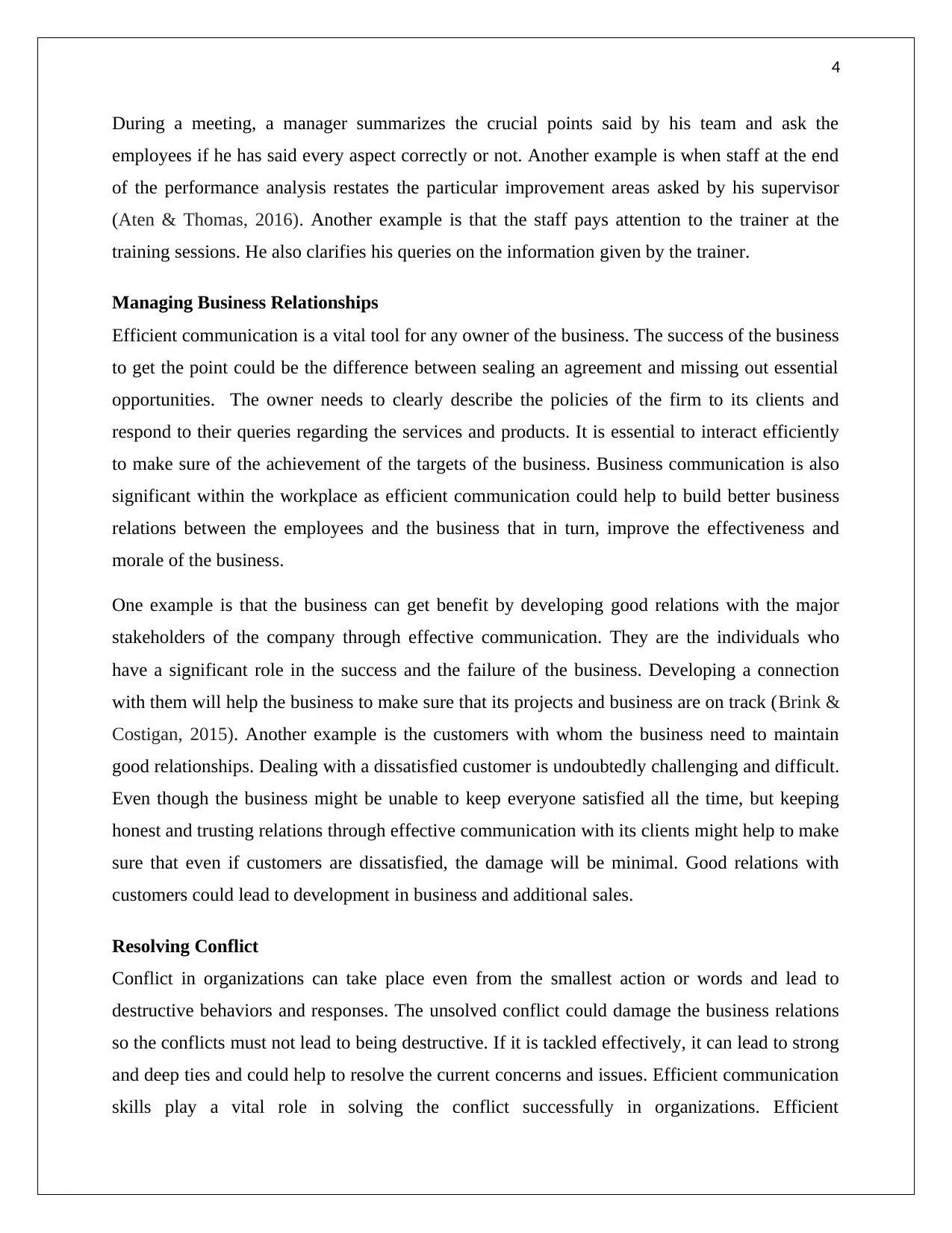
4
During a meeting, a manager summarizes the crucial points said by his team and ask the
employees if he has said every aspect correctly or not. Another example is when staff at the end
of the performance analysis restates the particular improvement areas asked by his supervisor
(Aten & Thomas, 2016). Another example is that the staff pays attention to the trainer at the
training sessions. He also clarifies his queries on the information given by the trainer.
Managing Business Relationships
Efficient communication is a vital tool for any owner of the business. The success of the business
to get the point could be the difference between sealing an agreement and missing out essential
opportunities. The owner needs to clearly describe the policies of the firm to its clients and
respond to their queries regarding the services and products. It is essential to interact efficiently
to make sure of the achievement of the targets of the business. Business communication is also
significant within the workplace as efficient communication could help to build better business
relations between the employees and the business that in turn, improve the effectiveness and
morale of the business.
One example is that the business can get benefit by developing good relations with the major
stakeholders of the company through effective communication. They are the individuals who
have a significant role in the success and the failure of the business. Developing a connection
with them will help the business to make sure that its projects and business are on track (Brink &
Costigan, 2015). Another example is the customers with whom the business need to maintain
good relationships. Dealing with a dissatisfied customer is undoubtedly challenging and difficult.
Even though the business might be unable to keep everyone satisfied all the time, but keeping
honest and trusting relations through effective communication with its clients might help to make
sure that even if customers are dissatisfied, the damage will be minimal. Good relations with
customers could lead to development in business and additional sales.
Resolving Conflict
Conflict in organizations can take place even from the smallest action or words and lead to
destructive behaviors and responses. The unsolved conflict could damage the business relations
so the conflicts must not lead to being destructive. If it is tackled effectively, it can lead to strong
and deep ties and could help to resolve the current concerns and issues. Efficient communication
skills play a vital role in solving the conflict successfully in organizations. Efficient
During a meeting, a manager summarizes the crucial points said by his team and ask the
employees if he has said every aspect correctly or not. Another example is when staff at the end
of the performance analysis restates the particular improvement areas asked by his supervisor
(Aten & Thomas, 2016). Another example is that the staff pays attention to the trainer at the
training sessions. He also clarifies his queries on the information given by the trainer.
Managing Business Relationships
Efficient communication is a vital tool for any owner of the business. The success of the business
to get the point could be the difference between sealing an agreement and missing out essential
opportunities. The owner needs to clearly describe the policies of the firm to its clients and
respond to their queries regarding the services and products. It is essential to interact efficiently
to make sure of the achievement of the targets of the business. Business communication is also
significant within the workplace as efficient communication could help to build better business
relations between the employees and the business that in turn, improve the effectiveness and
morale of the business.
One example is that the business can get benefit by developing good relations with the major
stakeholders of the company through effective communication. They are the individuals who
have a significant role in the success and the failure of the business. Developing a connection
with them will help the business to make sure that its projects and business are on track (Brink &
Costigan, 2015). Another example is the customers with whom the business need to maintain
good relationships. Dealing with a dissatisfied customer is undoubtedly challenging and difficult.
Even though the business might be unable to keep everyone satisfied all the time, but keeping
honest and trusting relations through effective communication with its clients might help to make
sure that even if customers are dissatisfied, the damage will be minimal. Good relations with
customers could lead to development in business and additional sales.
Resolving Conflict
Conflict in organizations can take place even from the smallest action or words and lead to
destructive behaviors and responses. The unsolved conflict could damage the business relations
so the conflicts must not lead to being destructive. If it is tackled effectively, it can lead to strong
and deep ties and could help to resolve the current concerns and issues. Efficient communication
skills play a vital role in solving the conflict successfully in organizations. Efficient
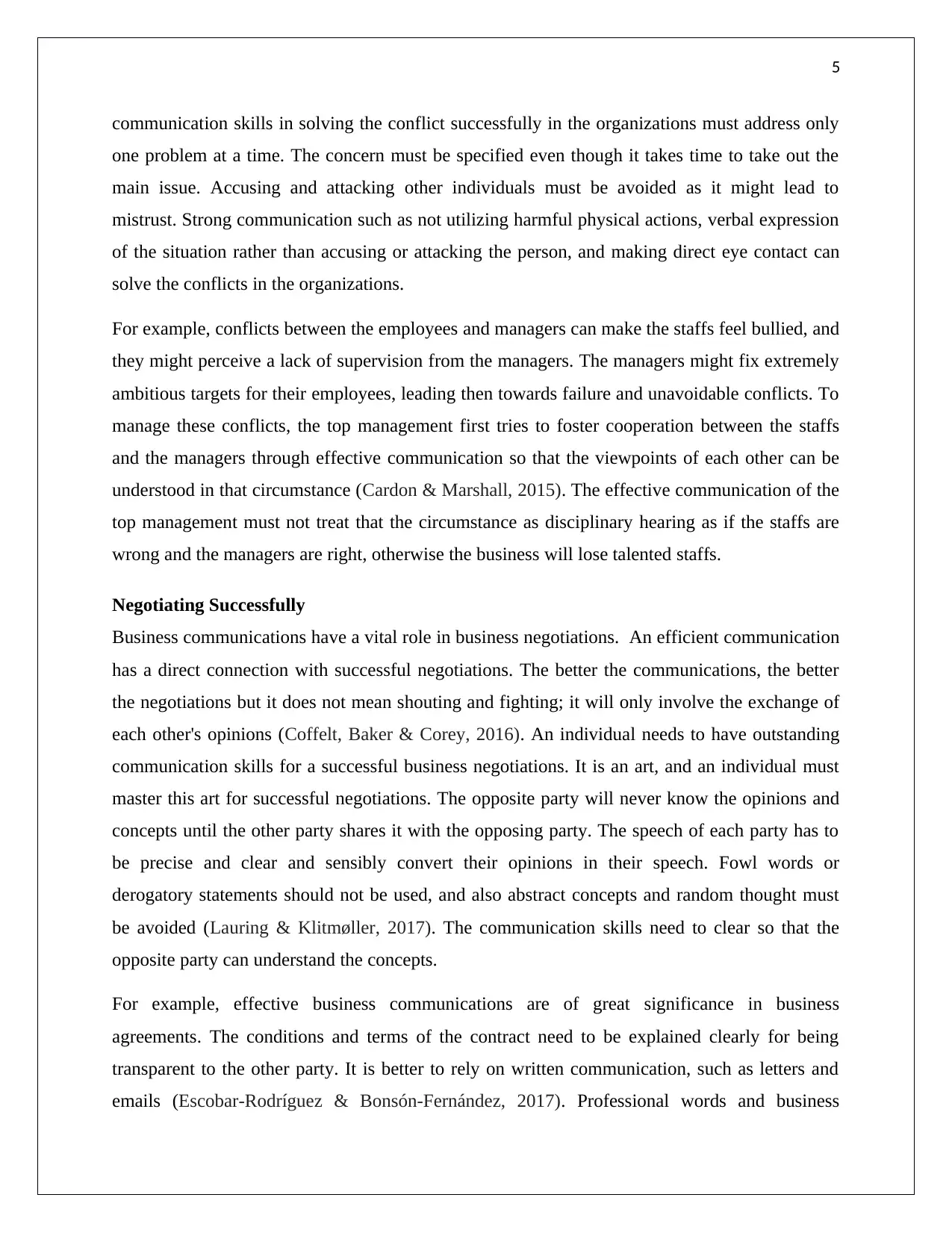
5
communication skills in solving the conflict successfully in the organizations must address only
one problem at a time. The concern must be specified even though it takes time to take out the
main issue. Accusing and attacking other individuals must be avoided as it might lead to
mistrust. Strong communication such as not utilizing harmful physical actions, verbal expression
of the situation rather than accusing or attacking the person, and making direct eye contact can
solve the conflicts in the organizations.
For example, conflicts between the employees and managers can make the staffs feel bullied, and
they might perceive a lack of supervision from the managers. The managers might fix extremely
ambitious targets for their employees, leading then towards failure and unavoidable conflicts. To
manage these conflicts, the top management first tries to foster cooperation between the staffs
and the managers through effective communication so that the viewpoints of each other can be
understood in that circumstance (Cardon & Marshall, 2015). The effective communication of the
top management must not treat that the circumstance as disciplinary hearing as if the staffs are
wrong and the managers are right, otherwise the business will lose talented staffs.
Negotiating Successfully
Business communications have a vital role in business negotiations. An efficient communication
has a direct connection with successful negotiations. The better the communications, the better
the negotiations but it does not mean shouting and fighting; it will only involve the exchange of
each other's opinions (Coffelt, Baker & Corey, 2016). An individual needs to have outstanding
communication skills for a successful business negotiations. It is an art, and an individual must
master this art for successful negotiations. The opposite party will never know the opinions and
concepts until the other party shares it with the opposing party. The speech of each party has to
be precise and clear and sensibly convert their opinions in their speech. Fowl words or
derogatory statements should not be used, and also abstract concepts and random thought must
be avoided (Lauring & Klitmøller, 2017). The communication skills need to clear so that the
opposite party can understand the concepts.
For example, effective business communications are of great significance in business
agreements. The conditions and terms of the contract need to be explained clearly for being
transparent to the other party. It is better to rely on written communication, such as letters and
emails (Escobar-Rodríguez & Bonsón-Fernández, 2017). Professional words and business
communication skills in solving the conflict successfully in the organizations must address only
one problem at a time. The concern must be specified even though it takes time to take out the
main issue. Accusing and attacking other individuals must be avoided as it might lead to
mistrust. Strong communication such as not utilizing harmful physical actions, verbal expression
of the situation rather than accusing or attacking the person, and making direct eye contact can
solve the conflicts in the organizations.
For example, conflicts between the employees and managers can make the staffs feel bullied, and
they might perceive a lack of supervision from the managers. The managers might fix extremely
ambitious targets for their employees, leading then towards failure and unavoidable conflicts. To
manage these conflicts, the top management first tries to foster cooperation between the staffs
and the managers through effective communication so that the viewpoints of each other can be
understood in that circumstance (Cardon & Marshall, 2015). The effective communication of the
top management must not treat that the circumstance as disciplinary hearing as if the staffs are
wrong and the managers are right, otherwise the business will lose talented staffs.
Negotiating Successfully
Business communications have a vital role in business negotiations. An efficient communication
has a direct connection with successful negotiations. The better the communications, the better
the negotiations but it does not mean shouting and fighting; it will only involve the exchange of
each other's opinions (Coffelt, Baker & Corey, 2016). An individual needs to have outstanding
communication skills for a successful business negotiations. It is an art, and an individual must
master this art for successful negotiations. The opposite party will never know the opinions and
concepts until the other party shares it with the opposing party. The speech of each party has to
be precise and clear and sensibly convert their opinions in their speech. Fowl words or
derogatory statements should not be used, and also abstract concepts and random thought must
be avoided (Lauring & Klitmøller, 2017). The communication skills need to clear so that the
opposite party can understand the concepts.
For example, effective business communications are of great significance in business
agreements. The conditions and terms of the contract need to be explained clearly for being
transparent to the other party. It is better to rely on written communication, such as letters and
emails (Escobar-Rodríguez & Bonsón-Fernández, 2017). Professional words and business
⊘ This is a preview!⊘
Do you want full access?
Subscribe today to unlock all pages.

Trusted by 1+ million students worldwide
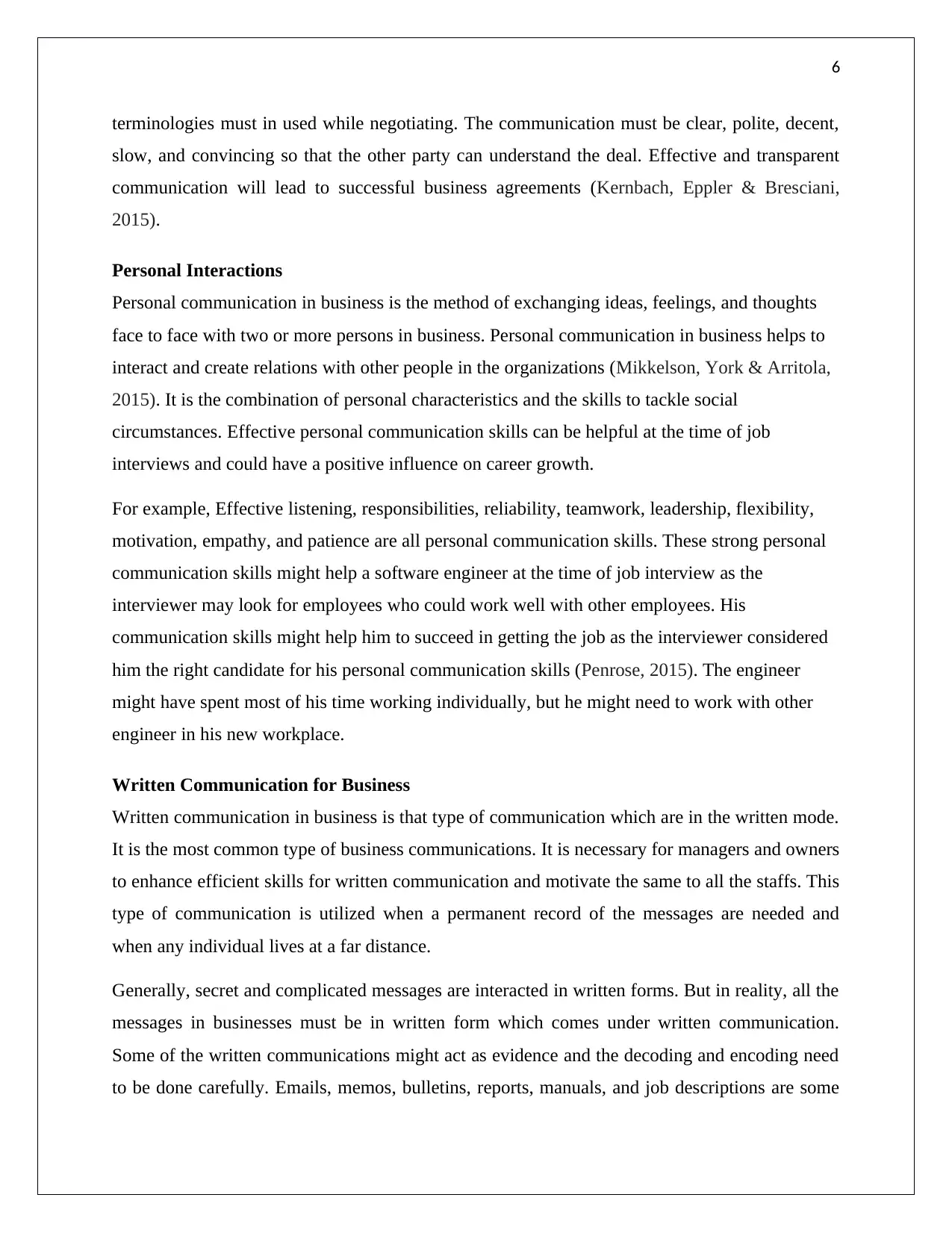
6
terminologies must in used while negotiating. The communication must be clear, polite, decent,
slow, and convincing so that the other party can understand the deal. Effective and transparent
communication will lead to successful business agreements (Kernbach, Eppler & Bresciani,
2015).
Personal Interactions
Personal communication in business is the method of exchanging ideas, feelings, and thoughts
face to face with two or more persons in business. Personal communication in business helps to
interact and create relations with other people in the organizations (Mikkelson, York & Arritola,
2015). It is the combination of personal characteristics and the skills to tackle social
circumstances. Effective personal communication skills can be helpful at the time of job
interviews and could have a positive influence on career growth.
For example, Effective listening, responsibilities, reliability, teamwork, leadership, flexibility,
motivation, empathy, and patience are all personal communication skills. These strong personal
communication skills might help a software engineer at the time of job interview as the
interviewer may look for employees who could work well with other employees. His
communication skills might help him to succeed in getting the job as the interviewer considered
him the right candidate for his personal communication skills (Penrose, 2015). The engineer
might have spent most of his time working individually, but he might need to work with other
engineer in his new workplace.
Written Communication for Business
Written communication in business is that type of communication which are in the written mode.
It is the most common type of business communications. It is necessary for managers and owners
to enhance efficient skills for written communication and motivate the same to all the staffs. This
type of communication is utilized when a permanent record of the messages are needed and
when any individual lives at a far distance.
Generally, secret and complicated messages are interacted in written forms. But in reality, all the
messages in businesses must be in written form which comes under written communication.
Some of the written communications might act as evidence and the decoding and encoding need
to be done carefully. Emails, memos, bulletins, reports, manuals, and job descriptions are some
terminologies must in used while negotiating. The communication must be clear, polite, decent,
slow, and convincing so that the other party can understand the deal. Effective and transparent
communication will lead to successful business agreements (Kernbach, Eppler & Bresciani,
2015).
Personal Interactions
Personal communication in business is the method of exchanging ideas, feelings, and thoughts
face to face with two or more persons in business. Personal communication in business helps to
interact and create relations with other people in the organizations (Mikkelson, York & Arritola,
2015). It is the combination of personal characteristics and the skills to tackle social
circumstances. Effective personal communication skills can be helpful at the time of job
interviews and could have a positive influence on career growth.
For example, Effective listening, responsibilities, reliability, teamwork, leadership, flexibility,
motivation, empathy, and patience are all personal communication skills. These strong personal
communication skills might help a software engineer at the time of job interview as the
interviewer may look for employees who could work well with other employees. His
communication skills might help him to succeed in getting the job as the interviewer considered
him the right candidate for his personal communication skills (Penrose, 2015). The engineer
might have spent most of his time working individually, but he might need to work with other
engineer in his new workplace.
Written Communication for Business
Written communication in business is that type of communication which are in the written mode.
It is the most common type of business communications. It is necessary for managers and owners
to enhance efficient skills for written communication and motivate the same to all the staffs. This
type of communication is utilized when a permanent record of the messages are needed and
when any individual lives at a far distance.
Generally, secret and complicated messages are interacted in written forms. But in reality, all the
messages in businesses must be in written form which comes under written communication.
Some of the written communications might act as evidence and the decoding and encoding need
to be done carefully. Emails, memos, bulletins, reports, manuals, and job descriptions are some
Paraphrase This Document
Need a fresh take? Get an instant paraphrase of this document with our AI Paraphraser
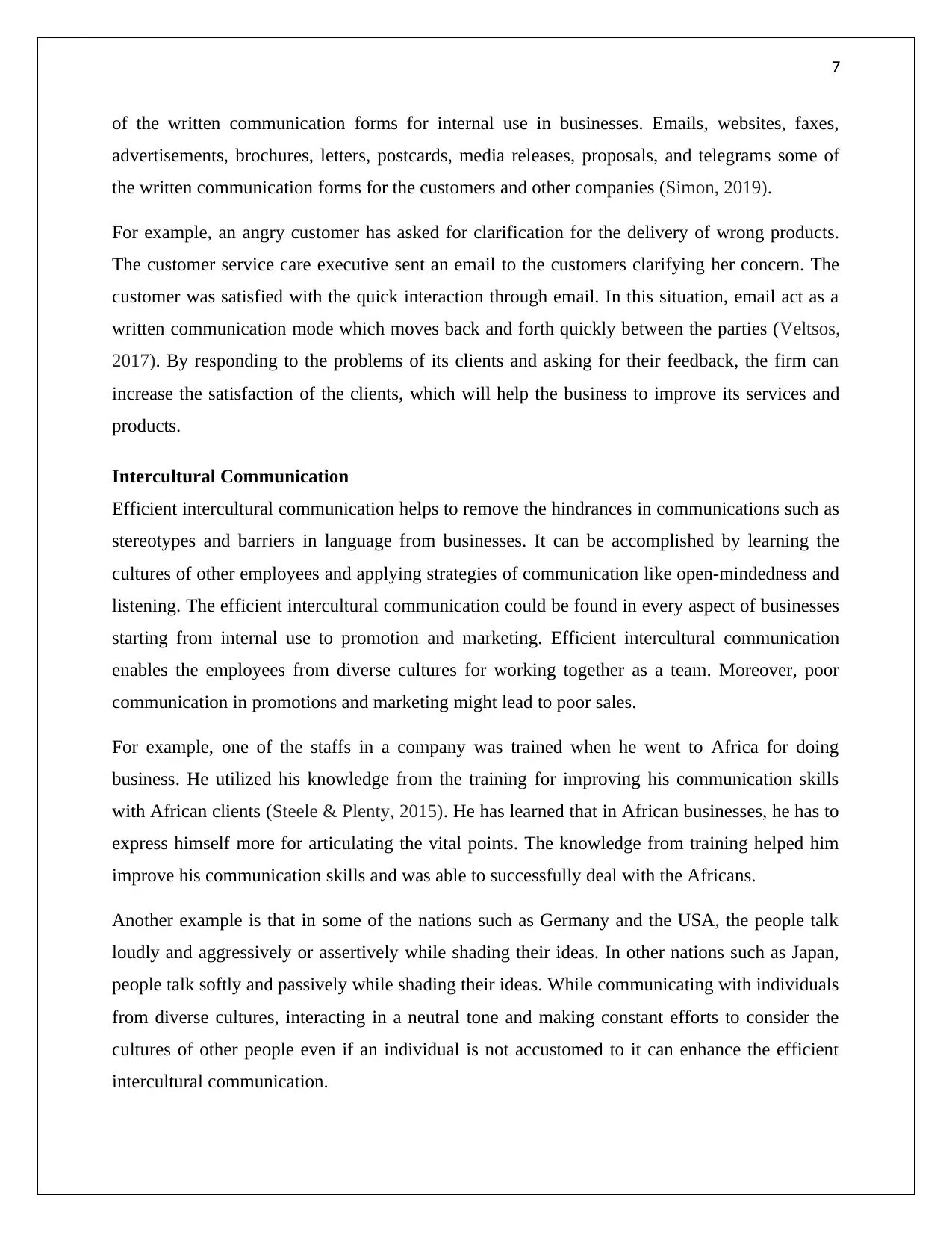
7
of the written communication forms for internal use in businesses. Emails, websites, faxes,
advertisements, brochures, letters, postcards, media releases, proposals, and telegrams some of
the written communication forms for the customers and other companies (Simon, 2019).
For example, an angry customer has asked for clarification for the delivery of wrong products.
The customer service care executive sent an email to the customers clarifying her concern. The
customer was satisfied with the quick interaction through email. In this situation, email act as a
written communication mode which moves back and forth quickly between the parties (Veltsos,
2017). By responding to the problems of its clients and asking for their feedback, the firm can
increase the satisfaction of the clients, which will help the business to improve its services and
products.
Intercultural Communication
Efficient intercultural communication helps to remove the hindrances in communications such as
stereotypes and barriers in language from businesses. It can be accomplished by learning the
cultures of other employees and applying strategies of communication like open-mindedness and
listening. The efficient intercultural communication could be found in every aspect of businesses
starting from internal use to promotion and marketing. Efficient intercultural communication
enables the employees from diverse cultures for working together as a team. Moreover, poor
communication in promotions and marketing might lead to poor sales.
For example, one of the staffs in a company was trained when he went to Africa for doing
business. He utilized his knowledge from the training for improving his communication skills
with African clients (Steele & Plenty, 2015). He has learned that in African businesses, he has to
express himself more for articulating the vital points. The knowledge from training helped him
improve his communication skills and was able to successfully deal with the Africans.
Another example is that in some of the nations such as Germany and the USA, the people talk
loudly and aggressively or assertively while shading their ideas. In other nations such as Japan,
people talk softly and passively while shading their ideas. While communicating with individuals
from diverse cultures, interacting in a neutral tone and making constant efforts to consider the
cultures of other people even if an individual is not accustomed to it can enhance the efficient
intercultural communication.
of the written communication forms for internal use in businesses. Emails, websites, faxes,
advertisements, brochures, letters, postcards, media releases, proposals, and telegrams some of
the written communication forms for the customers and other companies (Simon, 2019).
For example, an angry customer has asked for clarification for the delivery of wrong products.
The customer service care executive sent an email to the customers clarifying her concern. The
customer was satisfied with the quick interaction through email. In this situation, email act as a
written communication mode which moves back and forth quickly between the parties (Veltsos,
2017). By responding to the problems of its clients and asking for their feedback, the firm can
increase the satisfaction of the clients, which will help the business to improve its services and
products.
Intercultural Communication
Efficient intercultural communication helps to remove the hindrances in communications such as
stereotypes and barriers in language from businesses. It can be accomplished by learning the
cultures of other employees and applying strategies of communication like open-mindedness and
listening. The efficient intercultural communication could be found in every aspect of businesses
starting from internal use to promotion and marketing. Efficient intercultural communication
enables the employees from diverse cultures for working together as a team. Moreover, poor
communication in promotions and marketing might lead to poor sales.
For example, one of the staffs in a company was trained when he went to Africa for doing
business. He utilized his knowledge from the training for improving his communication skills
with African clients (Steele & Plenty, 2015). He has learned that in African businesses, he has to
express himself more for articulating the vital points. The knowledge from training helped him
improve his communication skills and was able to successfully deal with the Africans.
Another example is that in some of the nations such as Germany and the USA, the people talk
loudly and aggressively or assertively while shading their ideas. In other nations such as Japan,
people talk softly and passively while shading their ideas. While communicating with individuals
from diverse cultures, interacting in a neutral tone and making constant efforts to consider the
cultures of other people even if an individual is not accustomed to it can enhance the efficient
intercultural communication.
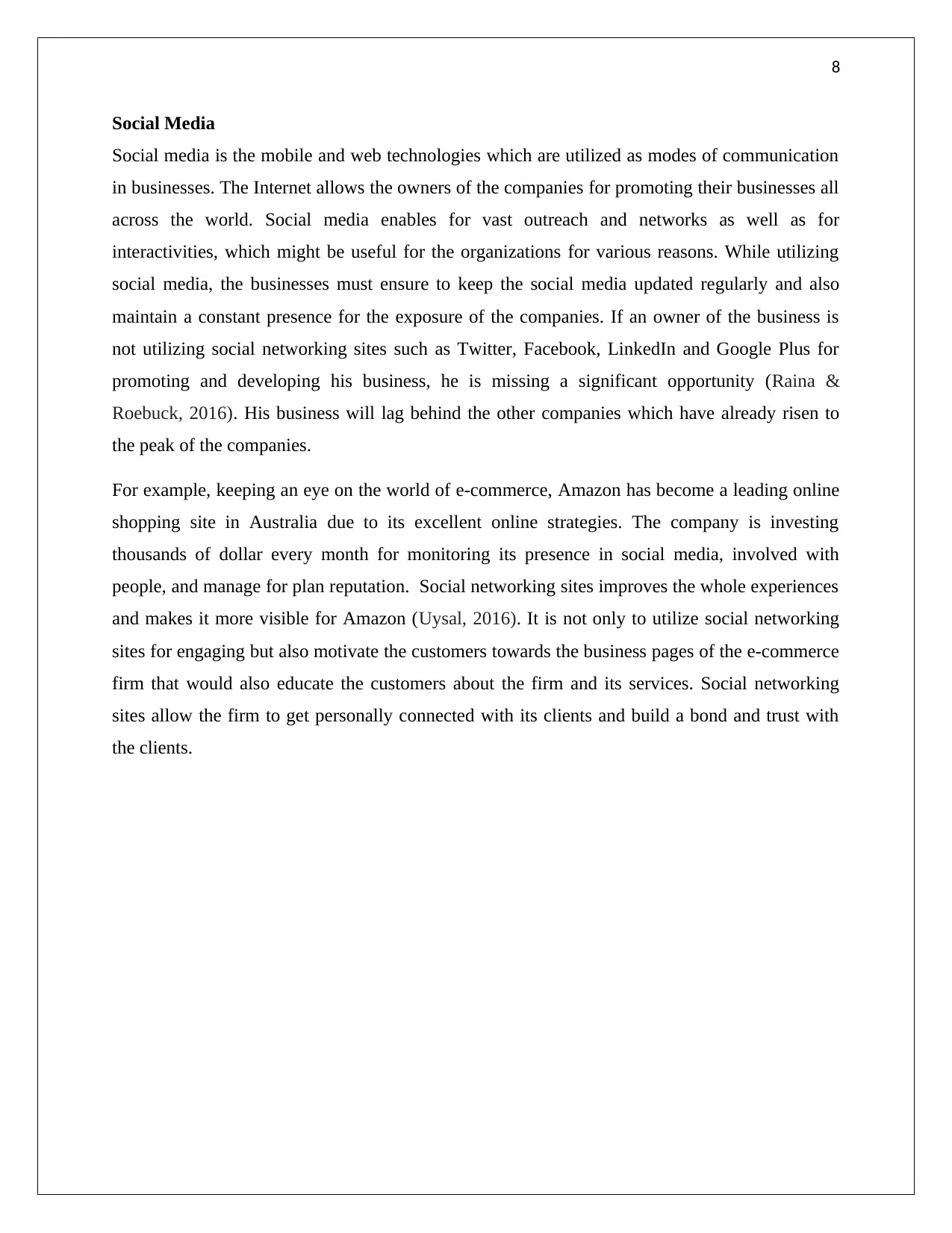
8
Social Media
Social media is the mobile and web technologies which are utilized as modes of communication
in businesses. The Internet allows the owners of the companies for promoting their businesses all
across the world. Social media enables for vast outreach and networks as well as for
interactivities, which might be useful for the organizations for various reasons. While utilizing
social media, the businesses must ensure to keep the social media updated regularly and also
maintain a constant presence for the exposure of the companies. If an owner of the business is
not utilizing social networking sites such as Twitter, Facebook, LinkedIn and Google Plus for
promoting and developing his business, he is missing a significant opportunity (Raina &
Roebuck, 2016). His business will lag behind the other companies which have already risen to
the peak of the companies.
For example, keeping an eye on the world of e-commerce, Amazon has become a leading online
shopping site in Australia due to its excellent online strategies. The company is investing
thousands of dollar every month for monitoring its presence in social media, involved with
people, and manage for plan reputation. Social networking sites improves the whole experiences
and makes it more visible for Amazon (Uysal, 2016). It is not only to utilize social networking
sites for engaging but also motivate the customers towards the business pages of the e-commerce
firm that would also educate the customers about the firm and its services. Social networking
sites allow the firm to get personally connected with its clients and build a bond and trust with
the clients.
Social Media
Social media is the mobile and web technologies which are utilized as modes of communication
in businesses. The Internet allows the owners of the companies for promoting their businesses all
across the world. Social media enables for vast outreach and networks as well as for
interactivities, which might be useful for the organizations for various reasons. While utilizing
social media, the businesses must ensure to keep the social media updated regularly and also
maintain a constant presence for the exposure of the companies. If an owner of the business is
not utilizing social networking sites such as Twitter, Facebook, LinkedIn and Google Plus for
promoting and developing his business, he is missing a significant opportunity (Raina &
Roebuck, 2016). His business will lag behind the other companies which have already risen to
the peak of the companies.
For example, keeping an eye on the world of e-commerce, Amazon has become a leading online
shopping site in Australia due to its excellent online strategies. The company is investing
thousands of dollar every month for monitoring its presence in social media, involved with
people, and manage for plan reputation. Social networking sites improves the whole experiences
and makes it more visible for Amazon (Uysal, 2016). It is not only to utilize social networking
sites for engaging but also motivate the customers towards the business pages of the e-commerce
firm that would also educate the customers about the firm and its services. Social networking
sites allow the firm to get personally connected with its clients and build a bond and trust with
the clients.
⊘ This is a preview!⊘
Do you want full access?
Subscribe today to unlock all pages.

Trusted by 1+ million students worldwide
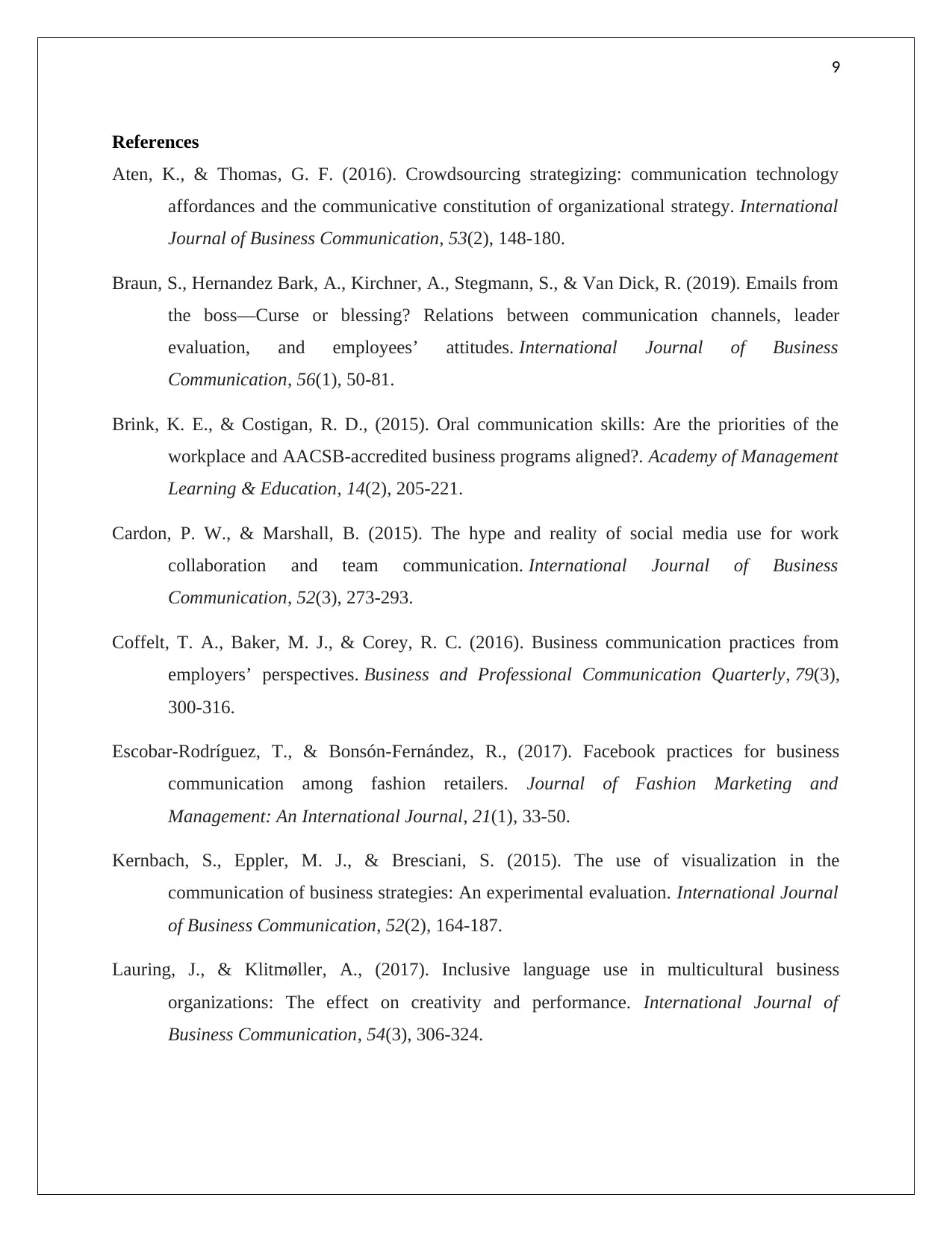
9
References
Aten, K., & Thomas, G. F. (2016). Crowdsourcing strategizing: communication technology
affordances and the communicative constitution of organizational strategy. International
Journal of Business Communication, 53(2), 148-180.
Braun, S., Hernandez Bark, A., Kirchner, A., Stegmann, S., & Van Dick, R. (2019). Emails from
the boss—Curse or blessing? Relations between communication channels, leader
evaluation, and employees’ attitudes. International Journal of Business
Communication, 56(1), 50-81.
Brink, K. E., & Costigan, R. D., (2015). Oral communication skills: Are the priorities of the
workplace and AACSB-accredited business programs aligned?. Academy of Management
Learning & Education, 14(2), 205-221.
Cardon, P. W., & Marshall, B. (2015). The hype and reality of social media use for work
collaboration and team communication. International Journal of Business
Communication, 52(3), 273-293.
Coffelt, T. A., Baker, M. J., & Corey, R. C. (2016). Business communication practices from
employers’ perspectives. Business and Professional Communication Quarterly, 79(3),
300-316.
Escobar-Rodríguez, T., & Bonsón-Fernández, R., (2017). Facebook practices for business
communication among fashion retailers. Journal of Fashion Marketing and
Management: An International Journal, 21(1), 33-50.
Kernbach, S., Eppler, M. J., & Bresciani, S. (2015). The use of visualization in the
communication of business strategies: An experimental evaluation. International Journal
of Business Communication, 52(2), 164-187.
Lauring, J., & Klitmøller, A., (2017). Inclusive language use in multicultural business
organizations: The effect on creativity and performance. International Journal of
Business Communication, 54(3), 306-324.
References
Aten, K., & Thomas, G. F. (2016). Crowdsourcing strategizing: communication technology
affordances and the communicative constitution of organizational strategy. International
Journal of Business Communication, 53(2), 148-180.
Braun, S., Hernandez Bark, A., Kirchner, A., Stegmann, S., & Van Dick, R. (2019). Emails from
the boss—Curse or blessing? Relations between communication channels, leader
evaluation, and employees’ attitudes. International Journal of Business
Communication, 56(1), 50-81.
Brink, K. E., & Costigan, R. D., (2015). Oral communication skills: Are the priorities of the
workplace and AACSB-accredited business programs aligned?. Academy of Management
Learning & Education, 14(2), 205-221.
Cardon, P. W., & Marshall, B. (2015). The hype and reality of social media use for work
collaboration and team communication. International Journal of Business
Communication, 52(3), 273-293.
Coffelt, T. A., Baker, M. J., & Corey, R. C. (2016). Business communication practices from
employers’ perspectives. Business and Professional Communication Quarterly, 79(3),
300-316.
Escobar-Rodríguez, T., & Bonsón-Fernández, R., (2017). Facebook practices for business
communication among fashion retailers. Journal of Fashion Marketing and
Management: An International Journal, 21(1), 33-50.
Kernbach, S., Eppler, M. J., & Bresciani, S. (2015). The use of visualization in the
communication of business strategies: An experimental evaluation. International Journal
of Business Communication, 52(2), 164-187.
Lauring, J., & Klitmøller, A., (2017). Inclusive language use in multicultural business
organizations: The effect on creativity and performance. International Journal of
Business Communication, 54(3), 306-324.
Paraphrase This Document
Need a fresh take? Get an instant paraphrase of this document with our AI Paraphraser
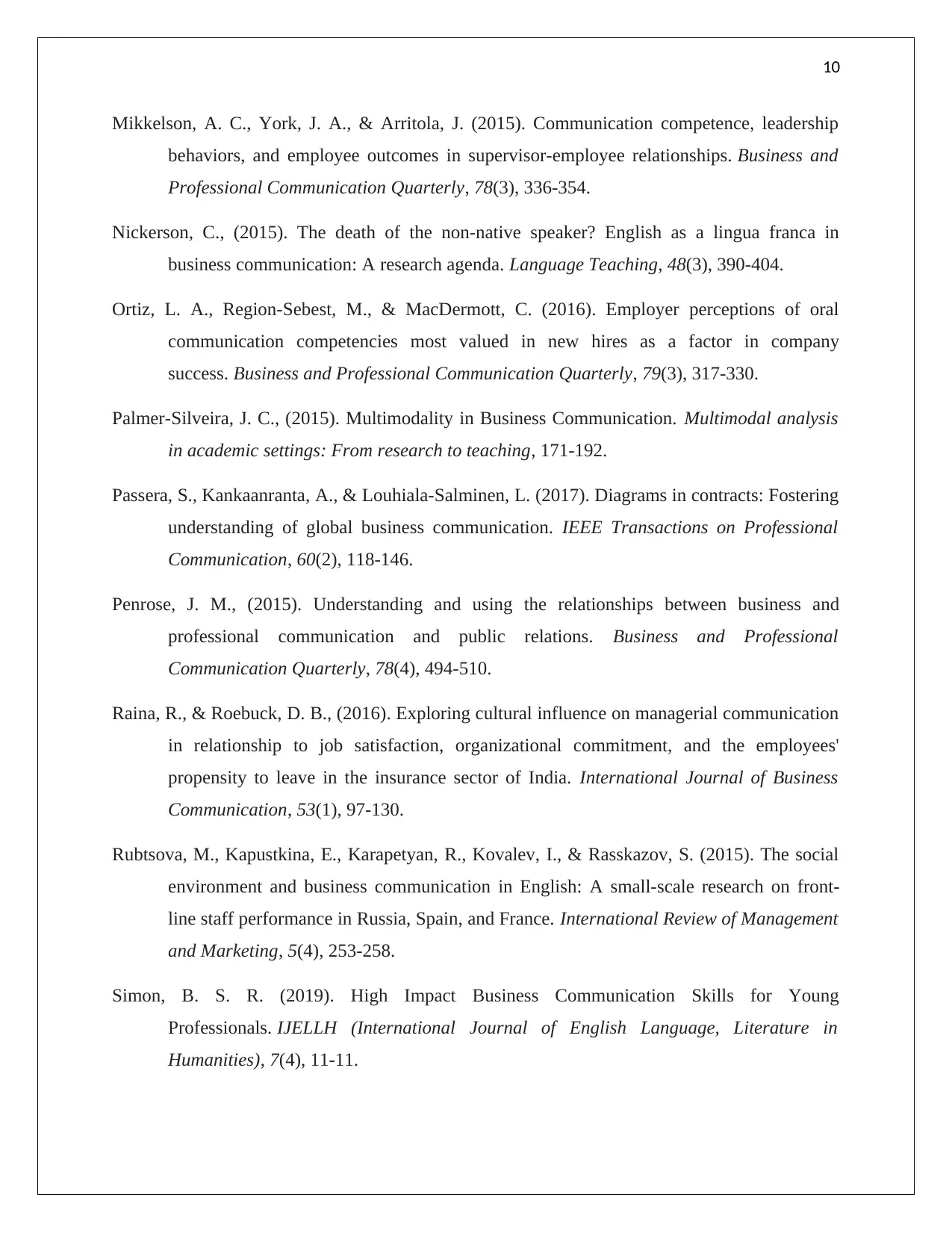
10
Mikkelson, A. C., York, J. A., & Arritola, J. (2015). Communication competence, leadership
behaviors, and employee outcomes in supervisor-employee relationships. Business and
Professional Communication Quarterly, 78(3), 336-354.
Nickerson, C., (2015). The death of the non-native speaker? English as a lingua franca in
business communication: A research agenda. Language Teaching, 48(3), 390-404.
Ortiz, L. A., Region-Sebest, M., & MacDermott, C. (2016). Employer perceptions of oral
communication competencies most valued in new hires as a factor in company
success. Business and Professional Communication Quarterly, 79(3), 317-330.
Palmer-Silveira, J. C., (2015). Multimodality in Business Communication. Multimodal analysis
in academic settings: From research to teaching, 171-192.
Passera, S., Kankaanranta, A., & Louhiala-Salminen, L. (2017). Diagrams in contracts: Fostering
understanding of global business communication. IEEE Transactions on Professional
Communication, 60(2), 118-146.
Penrose, J. M., (2015). Understanding and using the relationships between business and
professional communication and public relations. Business and Professional
Communication Quarterly, 78(4), 494-510.
Raina, R., & Roebuck, D. B., (2016). Exploring cultural influence on managerial communication
in relationship to job satisfaction, organizational commitment, and the employees'
propensity to leave in the insurance sector of India. International Journal of Business
Communication, 53(1), 97-130.
Rubtsova, M., Kapustkina, E., Karapetyan, R., Kovalev, I., & Rasskazov, S. (2015). The social
environment and business communication in English: A small-scale research on front-
line staff performance in Russia, Spain, and France. International Review of Management
and Marketing, 5(4), 253-258.
Simon, B. S. R. (2019). High Impact Business Communication Skills for Young
Professionals. IJELLH (International Journal of English Language, Literature in
Humanities), 7(4), 11-11.
Mikkelson, A. C., York, J. A., & Arritola, J. (2015). Communication competence, leadership
behaviors, and employee outcomes in supervisor-employee relationships. Business and
Professional Communication Quarterly, 78(3), 336-354.
Nickerson, C., (2015). The death of the non-native speaker? English as a lingua franca in
business communication: A research agenda. Language Teaching, 48(3), 390-404.
Ortiz, L. A., Region-Sebest, M., & MacDermott, C. (2016). Employer perceptions of oral
communication competencies most valued in new hires as a factor in company
success. Business and Professional Communication Quarterly, 79(3), 317-330.
Palmer-Silveira, J. C., (2015). Multimodality in Business Communication. Multimodal analysis
in academic settings: From research to teaching, 171-192.
Passera, S., Kankaanranta, A., & Louhiala-Salminen, L. (2017). Diagrams in contracts: Fostering
understanding of global business communication. IEEE Transactions on Professional
Communication, 60(2), 118-146.
Penrose, J. M., (2015). Understanding and using the relationships between business and
professional communication and public relations. Business and Professional
Communication Quarterly, 78(4), 494-510.
Raina, R., & Roebuck, D. B., (2016). Exploring cultural influence on managerial communication
in relationship to job satisfaction, organizational commitment, and the employees'
propensity to leave in the insurance sector of India. International Journal of Business
Communication, 53(1), 97-130.
Rubtsova, M., Kapustkina, E., Karapetyan, R., Kovalev, I., & Rasskazov, S. (2015). The social
environment and business communication in English: A small-scale research on front-
line staff performance in Russia, Spain, and France. International Review of Management
and Marketing, 5(4), 253-258.
Simon, B. S. R. (2019). High Impact Business Communication Skills for Young
Professionals. IJELLH (International Journal of English Language, Literature in
Humanities), 7(4), 11-11.
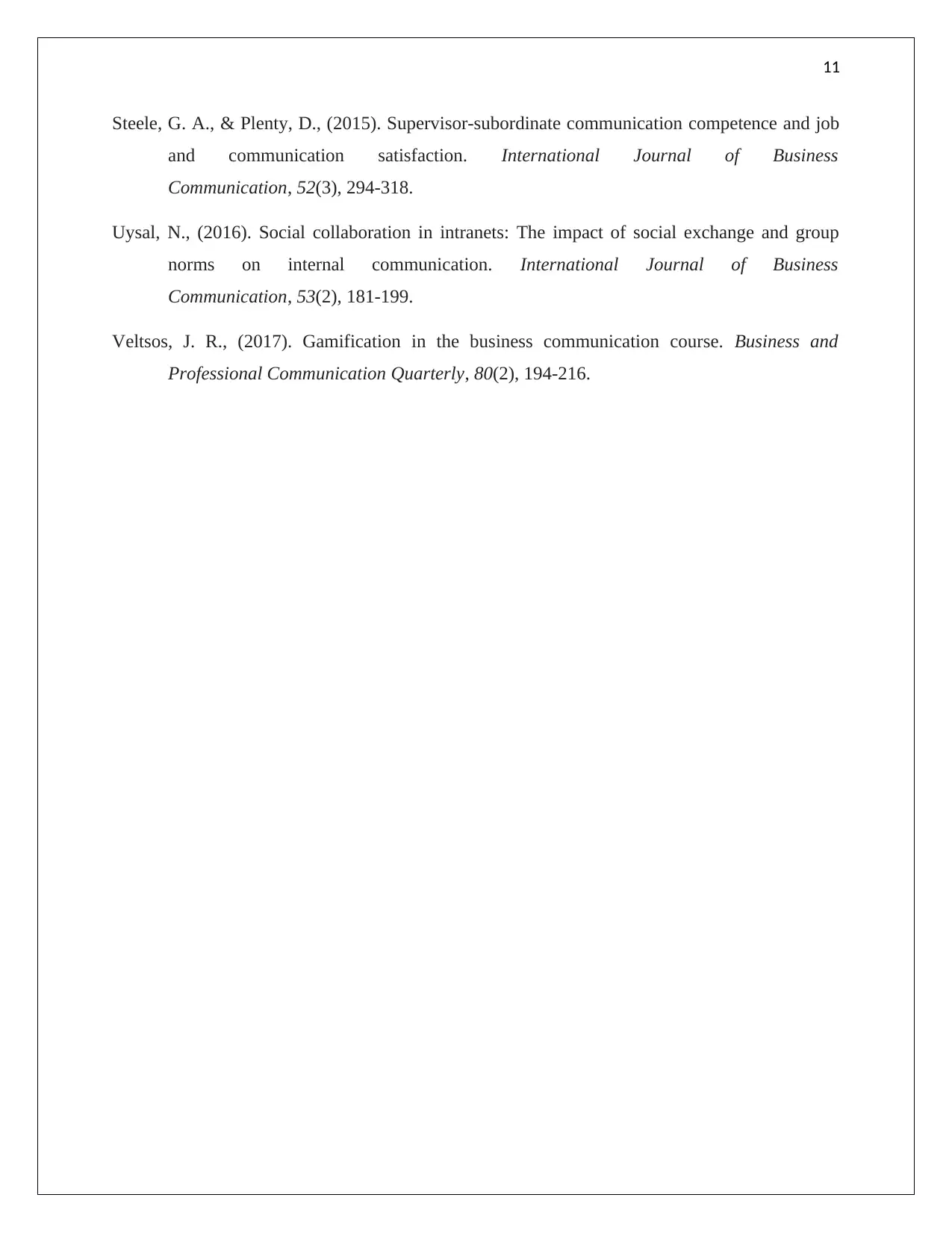
11
Steele, G. A., & Plenty, D., (2015). Supervisor-subordinate communication competence and job
and communication satisfaction. International Journal of Business
Communication, 52(3), 294-318.
Uysal, N., (2016). Social collaboration in intranets: The impact of social exchange and group
norms on internal communication. International Journal of Business
Communication, 53(2), 181-199.
Veltsos, J. R., (2017). Gamification in the business communication course. Business and
Professional Communication Quarterly, 80(2), 194-216.
Steele, G. A., & Plenty, D., (2015). Supervisor-subordinate communication competence and job
and communication satisfaction. International Journal of Business
Communication, 52(3), 294-318.
Uysal, N., (2016). Social collaboration in intranets: The impact of social exchange and group
norms on internal communication. International Journal of Business
Communication, 53(2), 181-199.
Veltsos, J. R., (2017). Gamification in the business communication course. Business and
Professional Communication Quarterly, 80(2), 194-216.
⊘ This is a preview!⊘
Do you want full access?
Subscribe today to unlock all pages.

Trusted by 1+ million students worldwide
1 out of 12
Related Documents
Your All-in-One AI-Powered Toolkit for Academic Success.
+13062052269
info@desklib.com
Available 24*7 on WhatsApp / Email
![[object Object]](/_next/static/media/star-bottom.7253800d.svg)
Unlock your academic potential
Copyright © 2020–2025 A2Z Services. All Rights Reserved. Developed and managed by ZUCOL.





